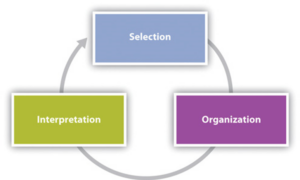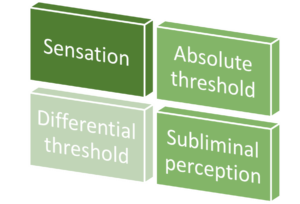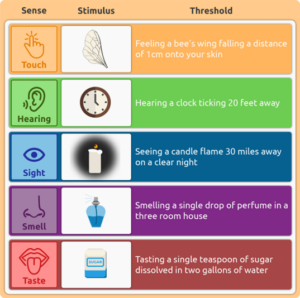ELEMENTS OF PERCEPTION IN CONSUMER BEHAVIOR
Perception is the process by which individuals select, organize, and interpret their sensory impressions in order to give meaning to their environment. However, what we perceive can be substantially different from objective reality. We often disagree about what is real. Consumers are faced with a wide variety of stimuli every day. They analyze and interpret each stimulus with their built-in screening systems. These systems help consumers to select and recognize what information is relevant to them and ignore what isn’t. Ultimately, this recognition leads to their purchasing decisions.

The elements of perception are:
- Sensation
- Absolute threshold
- Differential threshold
- Subliminal perception

SENSATION
Sensation is the immediate and direct response of the sensory organs to stimuli• A stimulus is any unit of input to any of the senses. Examples of stimuli (i.e., sensory input) include products, packages, brand names, advertisements, and commercials. Sensory receptors are the human organs (the eyes, ears, nose, mouth, and skin) that receive sensory inputs. Their sensory functions are to see, hear, smell, taste, and feel. All of these functions are called into play, either singly or in combination, in the evaluation and use of most consumer products.

Human sensitivity refers to the experience of sensation. Sensitivity to stimuli varies with the quality of an individual’s sensory receptors (e.g., eyesight or hearing) and the amount (or intensity) of the stimuli to which he or she is exposed. For example, a blind person may have a more highly developed sense of hearing than the average sighted person and may be able to hear sounds that the average person cannot, Sensation itself depends on energy change within the environment where the perception occurs (i.e., on differentiation of input). A perfectly bland or unchanging environment, regardless of the strength of the sensory input, provides little or no sensation at all.

As sensory input decreases, however, our ability to detect changes in input or intensity increases, to the point that we attain maximum sensitivity under conditions of minimal stimulation. This accounts for the statement, it was so quiet I could hear a pin drop. The ability of the human organism to accommodate itself to varying levels of sensitivity as external conditions vary not only provides more sensitivity when it is needed but also serves to protect us from damaging, disruptive, or irrelevant bombardment when the input level is high.

ABSOLUTE THRESHOLD
The lowest level at which an individual can experience a sensation is called the absolute threshold. The point at which a person can detect a difference between something and nothing is that person’s absolute threshold for that stimulus.

EXAMPLE: To illustrate, the distance at which a driver can note a specific billboard on a highway is that individual’s absolute threshold. Two people riding together may first spot the billboard at different times (i.e., at different distances); thus, they appear to have different absolute thresholds. Under conditions of constant stimulation, such as driving through a corridor of billboards, the absolute threshold increases (i.e., the senses tend to become increasingly dulled). After an hour of driving through billboards, it is doubtful that anyone billboard will make an impression.
Hence, we Often speak of getting used to a hot bath, a cold shower, or the bright sun. As our exposure to the stimulus increases, we notice it less. In the field of perception, the term adaptation refers specifically to getting used to certain sensations; that is, becoming accommodated to a certain level of stimulation.

Sensory adaptation is a problem that concerns many national advertisers, which is why they try to change their advertising campaigns regularly. They are concerned that consumers will get so used to their current print advertisements and TV commercials that they will no longer “see” them: that is, the advertisement will no longer provide sufficient sensory input to be noted. In an effort to cut through the advertising clutter and ensure that consumers note their advertisement, some marketers try to increase sensory input.
For example, Apple Computer once bought all the advertising space in an issue of Newsweek magazine to ensure that readers would note its ads. From time to time, various advertisers have taken all of the bus cards on certain bus routes to advertise their products; ensuring that wherever a rider sits, he or she will be exposed to the advertisement. Other advertisers try to attract attention by decreasing sensory input.
For example, some print advertisement include a lot Of empty space in order to accentuate the brand name or product; illustration, and some TV advertisement use silence, the absence of audio sound, to generate’ attention. Depicts the use of increased sensory input to support the product’s advertising claim, some marketers seek unusual or technological media in which to place their advertisements in an effort to gain attention.
Examples of such media include small monitors attached to shopping carts that feature actual brands in TV shows and in movies, individual TV .screens (placed in the back of the seat ahead) on airplanes, and monitors integrated into the above the-door floor indicators on ‘elevators. Fragrance marketers often include fragrance samples in their direct mail and magazine advertisements through sealed perfume inserts.

Researchers have reported that the use Of an ambient 37 scent in a retail environment enhances the shopping experience or consumers and makes the time they spend examining merchandise, waiting in line, and waiting for help seem shorter than it actually is. Some marketers have invested in the development of specially engineered scents to enhance their products and entice consumers to buy, Package designers try to determine consumers’ absolute thresholds to make sure that their new product designs will stand out from competitors’ packages on retailers’ shelves.
DIFFERENTIAL THRESHOLD
The minimal difference that can be detected between two similar stimuli is called the differential threshold, or the just noticeable difference (the J.N.D.). A nineteenth-century German scientist named Ernst Weber discovered that the J.N.D. between two stimuli was not an absolute amount, but an amount relative to the intensity of the first stimulus. Weber’s law, as it has come to be known, states that the stronger the initial stimulus, the greater the additional intensity needed for the second stimulus to be perceived as different.

According to Weber’s law, an additional level of stimulus equivalent to the J.N.D. must be added for the majority of people to perceive a difference between the resulting stimulus and the initial stimulus.
Weber’s law has important applications in marketing. Manufacturers and marketers endeavor to determine the relevant J.N.D. for their products for two very different reasons:
(1) so that negative changes (e.g., reductions in product size or quality, or increases in product price) are not readily discernible to the public (they remain below the J.N.D.) and
(2) so that product improvements (such as improved or updated packaging, larger size, or lower price) are very apparent to consumers with-out being wastefully extravagant (i.e., they are at or just above the J.N.D.).

When it comes to product improvements, marketers very much want to meet or exceed the consumer’s differential threshold; that is, they want consumers to readily perceive any improvements made in the original product. Marketers use the J.N.D. to determine the amount of improvement they should make in their products. LeM than the J.N.D. is wasted effort because the improvement will not be perceived; more than the J.N.D. is wasteful because it reduces the level of repeat sales. On the other hand, when it comes to price increases, less than the J.N.D. is desirable because consumers are unlikely to notice it.
Since many routinely purchased consumer goods are rather inexpensive, companies are reluctant to raise prices when their profit margins on these items are declining. Instead, many marketers decrease the product quantity included in the packages, while leaving the prices unchanged -thus, in effect, increasing the per unit price.

Marketers often want to update their existing package designs without losing the ready recognition of consumers who have been exposed to years of cumulative advertising impact. In such cases, they usually make a number of small changes, each carefully designed to fall below the J.N.D. so that consumers will perceive minimal difference between succeeding versions. For example, Betty Crocker’ the General Mills symbol, has been updated seven times from 1936 to 1996.
SUBLIMINAL PERCEPTION

A Stimuli that are too weak or too brief to be consciously seen or heard.
- They may be strong enough to be perceived by one or more receptor cells.
- Is it effective?
- Extensive research has shown no evidence that subliminal advertising can cause behavior changes.

- Some evidence that subliminal stimuli may influence affective reactions
- Subliminal perception occurs when stimulus is below the level of the consumer’ s awareness.
- Rumors of subliminal advertising are rampant—though there’s little proof that it occurs.
- Most researchers believe that subliminal techniques are not of much use in marketing.

ELEMENTS OF PERCEPTION IN CONSUMER BEHAVIOR